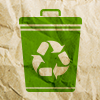It’s something we hear all the time. Our natural resources such as coal, oil and metals are dwindling, and the depletion of these resources destroys natural habitats. Despite the fact that many cities offer recycling programs to help combat this concern, people often feel recycling at home is more trouble than it’s worth. If you need a little more incentive to get into the habit, think about the fact that recycling also saves energy.
Recycling Benefits
 Walk around any store, and you are looking at products that took energy to produce them, particularly plastic and metal items. By using recycled materials, companies need less energy for production than making an item from scratch. Refining metal is a lengthy and expensive process and requires unbelievable amounts of water and petroleum.
Walk around any store, and you are looking at products that took energy to produce them, particularly plastic and metal items. By using recycled materials, companies need less energy for production than making an item from scratch. Refining metal is a lengthy and expensive process and requires unbelievable amounts of water and petroleum.
According to the EPA, using recycled aluminum only uses 5% of the energy and emissions that are needed to extract new aluminum. Even with the energy used to collect, process, and transport recycled materials, making products from them takes less energy because the materials have already undergone the inefficient initial processing. That’s simplifying a complicated scenario, but consider these recycling examples provided by the EPA and state energy agencies:
- Recycling 10 aluminum cans saves enough energy to power almost 52 hours of a laptop.
- Even recycling just ONE aluminum can saves enough energy to watch television for 3 hours.
- Recycling 1 plastic bottle a day for a month saves enough energy to power nearly 300 hours of a 60W CFL lightbulb.
- Recycling paper cuts energy usage in half. (America’s daily use of computer paper could go around the world 40 times!)
- Recycling a ton of glass saves the equivalent of nine gallons of fuel oil.
- Recycling one million laptops saves the energy equivalent to the electricity used by more than 3,500 US homes in a year. The next time you buy new electronics such as computers and cell phones, think of turning the old ones in to an electronics store for recycling.
Recycling at Home
 So what can you do to recycle at home? Start small, and think of how you can reduce the need to purchase new products. Reduce food waste by eating the food you have already and reusing jars and containers instead of buying more. Purchase food products in concentrate or bulk to reduce packaging waste, and look for products that are made with recycled materials. Instead of buying products like paper towels or dust wipes, reuse rags or old socks for cleaning.
So what can you do to recycle at home? Start small, and think of how you can reduce the need to purchase new products. Reduce food waste by eating the food you have already and reusing jars and containers instead of buying more. Purchase food products in concentrate or bulk to reduce packaging waste, and look for products that are made with recycled materials. Instead of buying products like paper towels or dust wipes, reuse rags or old socks for cleaning.
Check out the EPA’s Reduce, Reuse, and Recycle website for more home recycling tips. Or, take the next step and start recycling items that you would normally dump in the trash. To search for recycling locations near you, log onto RecyclerFinder.com.


 This one may be surprising because cardboard—out of which most pizza boxes are made—is practically the consummate recyclable material. But as the folks over at
This one may be surprising because cardboard—out of which most pizza boxes are made—is practically the consummate recyclable material. But as the folks over at  Think it’s good to recycle plastic? You’re right! Just not this kind of plastic. According to Rebin, a
Think it’s good to recycle plastic? You’re right! Just not this kind of plastic. According to Rebin, a  Batteries today can be thrown out with your trash because they do not have as much mercury as those before 1997, when new mandates to phase out mercury were passed. But if you come upon older batteries or feel environmentally conscious about causally tossing them out, there are various recycling options from which you can choose. Older batteries contain
Batteries today can be thrown out with your trash because they do not have as much mercury as those before 1997, when new mandates to phase out mercury were passed. But if you come upon older batteries or feel environmentally conscious about causally tossing them out, there are various recycling options from which you can choose. Older batteries contain  Ever wonder how paper cups are made to hold hot beverages, but are also recyclable? Unfortunately, only one of those two things is true. Most paper cups are made out of a
Ever wonder how paper cups are made to hold hot beverages, but are also recyclable? Unfortunately, only one of those two things is true. Most paper cups are made out of a  According to the pop culture site Konbini, a woman mistakenly tried to recycle an extremely rare, extremely valuable piece of
According to the pop culture site Konbini, a woman mistakenly tried to recycle an extremely rare, extremely valuable piece of  According to Time Magazine, Nike has made soccer uniforms for both the U.S.
According to Time Magazine, Nike has made soccer uniforms for both the U.S.  That’s right. There’s an
That’s right. There’s an  It’s always a magical moment when caps fly through the air to commemorate the achievement of a hard-earned degree. But the next time your heart swells thinking about your family member’s upcoming commencement ceremony, allow it to swell an extra size or two,
It’s always a magical moment when caps fly through the air to commemorate the achievement of a hard-earned degree. But the next time your heart swells thinking about your family member’s upcoming commencement ceremony, allow it to swell an extra size or two,  You’d never believe what’s holding up some building in Norway. We’ll give you a hint: it’s black and white and read all over. No, it’s not a sunburned penguin; for one thing, you’ve got to work on your homophones. For another, sunburned penguins are unionized. Too expensive.
You’d never believe what’s holding up some building in Norway. We’ll give you a hint: it’s black and white and read all over. No, it’s not a sunburned penguin; for one thing, you’ve got to work on your homophones. For another, sunburned penguins are unionized. Too expensive. We know what you’re thinking. “Why would I want to brush my teeth with garbage?” We assure you, the
We know what you’re thinking. “Why would I want to brush my teeth with garbage?” We assure you, the